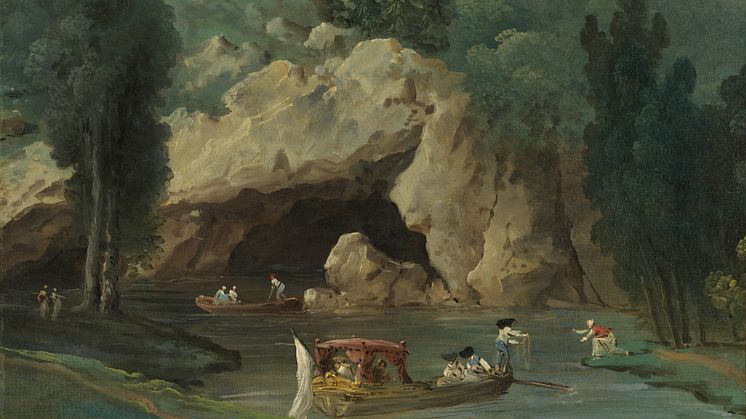
Press release -
New Acquisition: Boats in Front of the Grotto in the Park at Méréville by Hubert Robert
Nationalmuseum recently acquired a small painting by Hubert Robert that shows a view of the park in Méréville, probably executed in 1786-87. Robert has primarily become known for his picturesque vedute of Rome, often composed of a fantasized conglomeration of various famous ruins and monuments. His work as a garden designer is less known. The newly acquired painting was created in connection with the work Hubert Robert carried out in the park at Méréville for the wealthy banker, the Marquis Jean-Joseph de Laborde.
The French artist Hubert Robert (1733-1808), also known as "Robert des ruines,” is primarily associated with his magnificent and picturesque views of Rome, where he lived for more than a decade starting in 1754. Upon his return to Paris in 1765, he was already a big name and continued to create fantasy pictures featuring combinations of various monuments, so-called capriccios, as well as views of Paris. Robert kept working with the theme of ruins, as well as related topics such as fires and destruction.
Robert’s artistic merits soon also led to his appointment as Royal Garden Designer, dessinateur des Jardins du Roy. However, Robert had very little in common with his renowned predecessor, André Le Nôtre, because he does not appear to have ever transformed any of his blueprints into actual gardens. Instead, his primary contributions were drawings and paintings depicting various views of the planned landscaping projects. Nor is there much evidence that Robert himself staked out any parks on the basis of his artistic creations. His paintings instead served as advertising images intended for the client. At the same time, they could serve as a guide for the different specialists, of which Robert was the coordinating force. These included architects, sculptors and gardeners. Without their help, he would never have been able to realize some of his ideas for gardens and parks. Robert was thus more of an entrepreneur and designer.
The recently acquired painting is almost certainly an example of Robert’s unique method of using oil paintings to create gardens and parks, in this case Méréville, located 65 km southwest of Paris. Robert was employed by its owner, the Marquis Jean-Joseph de Laborde, in 1786. The entire project came to an abrupt end when the Marquis was guillotined in 1794. Up until that date, feverish activity and extensive construction work was carried out in the park. In addition to a variety of pavilions and monuments, several artificial grottos were added. Robert had experience with such work, including from Versailles, where a decade earlier he created a picturesque grotto formation around François Girardon and Thomas Regnaudin’s 17th century sculpture group, Les Bains d'Apollon, in one of the garden installations. Robert brought the same artists with whom he had worked at Versailles to Méréville, among them the sculptor Yves-Éloi Boucher, nephew of the famous François Boucher. He and several others are mentioned in Robert's correspondence with the Marquis de Laborde as being responsible for creating three-dimensional models for the large caves in Méréville. Among other resources, Robert’s paintings, such as Nationalmuseum’s recent acquisition, served as inspirations and guides for the endeavor. Boats in Front of the Grotto in the Park at Méréville may be compared to Robert’s other paintings in Nationalmuseum with views from Méréville (NM 2794-2795 NM), which depict the large grottos, the cascade, the rustic wooden bridge, and the pavilion.
Nationalmuseum has no funds of its own with which to acquire applied art, design and artwork, the collections are enriched through donations and funds from private foundations and trusts. The acquisition of the painting by Robert has been made possible by funds from the Hedda and N.D. Qvist Memorial Fund.
Inventory number NM 7480
Further Information
Magnus Olausson, Director of Collections and Research, magnus.olausson@nationalmuseum.se, 08-5195 4371
Hanna Tottmar, Head of press, press@nationalmuseum.se, 08-5195 4400
Categories
Nationalmuseum is Sweden’s museum of art and design. The collections comprise older paintings, sculpture, drawings and graphic art, and applied art and design up to the present day. The museum building has currently been renovated and reopened October 13, 2018. Nationalmuseum has partnerships with Svenska Dagbladet and the Grand Hôtel Stockholm.

